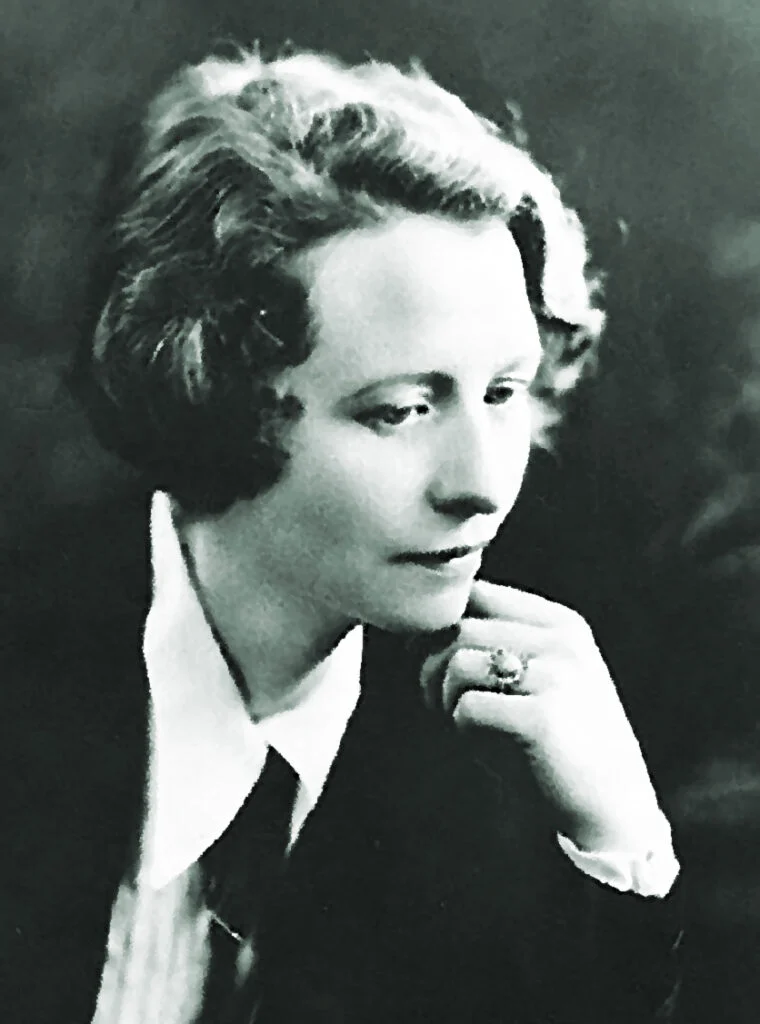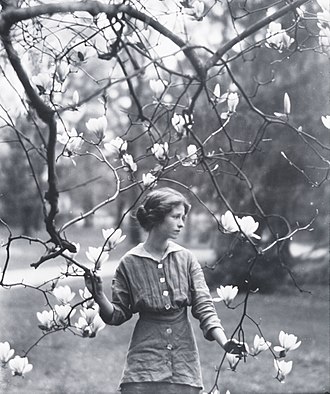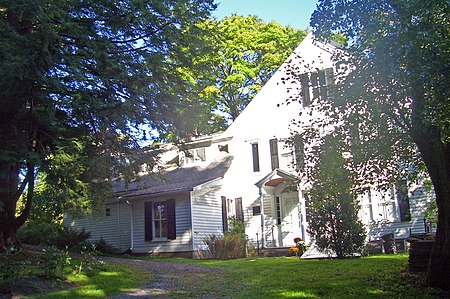
Edna en Plein Air: “Dip the Song in the Stream”
by Antonia Shoumatoff
Edna St. Vincent Millay (1892-1950) was the High Priestess of the nineteen-twenties, practicing free love and breaking the rules. I was a child of the nineteen-sixties, I and had always resonated with the rebellious intellectuals of that period. Her poems famously celebrate trees, plants, and animals, echoing her exquisite sense of harmony with the natural surroundings she loved. When I discovered that she lived nearby in Austerlitz, I wanted to investigate.
I wanted to know more about what sparked her natural poetic genius, so I literally walked her poems into the forest, seeking to lift those lyrics off the page and out into the trees and streams that she writes about.
First, I followed a trail that led to a babbling stream, one of my favorite places for contemplation. Stones interspersed with bright turquoise broken pottery, bright turquoise, and purple slag left over from the Iron Ore industry in our area adorned the banks that flooded so many times last spring.
The cooing calls of a mourning dove punctuated the little white crests of water flowing over the rocks. What a refreshing, rushing sound, echoed by the wind rustling through the leaves. Taking a deep breath, I opened Vincent’s dauntingly thick book of collected poems, haunted by the familiar feeling of doubt about my readiness to truly appreciate them. The poet herself swept the doubt away as I fortuitously opened to the words:
Ah, drink again, this river that is the taker-away of pain and the giver- back of beauty…immerse the dream. Drench the kiss…dip the song in the stream. The words whooshed through me. I felt as if I had been given an amazing gift from the poet, had been blessed by her muse. For months I had tried to understand what made her tick, but it was in that one moment that insight came rushing through.
The words had suddenly become alive in their natural place of origin. This was more than synchronicity or coincidence: I had cracked a code. As I continued to delve into her poetry, I saw almost every page as dancing with images celebrating nature.

Having previously doubted my ability to unravel the imagery of poetry, this was a major breakthrough. It had always seemed as if there were an invisible wall between me and the words, that the meaning would remain ineffable, known only to the poet who had birthed them in pain and solitude. The cavalcades of words placed by poets on the page had been unwelcome gates, begging to be crashed open, beckoning my senses to go beyond their code. But I never quite had the patience to go beyond their daunting verbal barricade. At that moment, I became aware of birds and their trilling sounds above me in the trees as I slowly turned the page to read Millay’s words:
… I shuddered at his cry, and it caught my heart…
He cried forever from his unseen throat
between me and the sun…
He would not end his singing,
He would not have done.
“‘Serene and pitiless note,
whence, whence, are you?”
… Even as I spoke
he was revealed above me
in the bright air…
and called him by his name;
‘Blithe Spirit!’ I cried.
Edna St. Vincent Millay, who preferred to be called ‘Vincent’, was herself a blithe spirit. Raised by a single mother in Maine, she wrote during a time when women could not vote. With an uncommon ability to seduce, she used words in a way that made people fall in love with her. She was totally fearless. She transformed herself evolved from a waif, to a pixie, to a Celtic goddess in shimmering robes, reading her poetry for the nation over the radio airwaves in the thirties.
Vincent became an icon for her age because she was able to ignite people with lines such as these:
We were very tired, we were very merry—
we had gone back and forth all night on the ferry.
She started sonnets with such compelling phrases like “only until this cigarette has ended….” Writing at a time when poets could be rock stars, this poet’s presence could fill rooms with thousands of people as they “burned the candle at both ends.” She ran wild, drank liquor, wore pants and had as many affairs as it pleased her to enjoy.
Typical of a rock star, Millay also had an addictive personality, dealt with chronic pain by using opiates, and died an early tragic death, falling down the stairs while intoxicated.
Ultimately, my journey to understanding how nature’s transcendence informed Edna St. Vincent Millay’s work took me to her home, Steepletop, in Austerlitz, New York.
She had moved to the Hudson Valley begrudgingly in 1925 from 75 ½ Bedford Street in New York City’s West Village. Her dream was to move back to her beloved rocky coast of Maine, but that would be too far from her publisher, Harper’s, in New York. She and her husband, the Dutch importer Eugen Boissevain, bought a Sears and Roebuck kit house on 600 acres that they found through and ad in the New York Times after she became the first woman to win the Pulitzer Prize (1923) for poetry and had four books on the best seller list. Both deeds for the property were in her name.
Millay was already familiar with the Hudson Valley, having attended Vassar College and had lived in Cold Spring, on the Hudson, in a summer writers’ colony that included Bohemian writers and such radical intellectuals as Max Eastman and John Reed. She named her house after the steeple-bush that still blooms on her property, and cultivated low-bush blueberries that reminded her of Maine. She put in wooden gates to create ‘outside interiors’ and contemplative walkways that led to her wildflower gardens and her writer’s cabin, a tiny wooden structure in a piney grove of transplanted balsam firs from Maine.

She said she ‘commuted to work’ as she passed through the wildflower rock gardens she had installed, hiding them away up behind the shady pines. She always wrote in pencil, and set her alarm clock for three-and-a-half-hours of writing, starting at 2 p.m. Her cabin was unadorned and spartan. She once wrote:
Through the green forest softly without a sound,
wrapped in a still mood,
as in a cloak and hood I went,
and cast no shadow
in the shadow of the wood.
Vincent seemed to perpetually miss the sea and complained of having to “till the rocky upland soil.” In a poem called “Exiled” she exclaimed: “I should be happy… yet I have need to hold and handle shells and anchors and ships again! I should be happy… never at all since I came here. I am too long away from the water.”
Most of the flowers she planted and loved the best were blue like the sea. She planted fields of blue lupines outside her bedroom window, which swayed in the wind, reminding her of the ocean and borage outside her kitchen window:
Borage, forage for bees and for those who love blue,
why must you, having only been transplanted,
from where you were not wanted either by the bee or by me,
from under the sage, engage in this self-destruction?
A transplant herself, from Maine, the poet was able to identify even with weeds. Slowly, as she strode across the property, the land began to grab Vincent’s senses as she played with words that helped her find herself through the New England flowers and shrubs she planted. Finding solace in almost every shrub and tree, she even wrote an elegy to her strange strawberry shrub, calling it old fashioned, “quaint as quinces, hard to find in a world where neon and noise have flattened the ends of the three more subtle senses…more brown than red the bloom—it is a dense color; color of dried blood; color of the key of F…purple a little, the bloom, like musty chocolate.”
When she planted an herb and vegetable garden outside her back kitchen door she cherished every “weed,” be it burdock, sorrel, or daisy. Putting food on her windowsill for the birds, she jotted down notes about them with an almost mystical sensibility. She called herself a lazy gardener:
She digs in her garden with a shovel and a spoon, she weeds her lettuce by the light of the moon… Her lawn looks like a meadow, And if she mows the place, she leaves the clover standing and the Queen Anne’s lace. Although Vincent made a noble attempt to relate to the magical places she created on her estate in upstate New York, her poetry still abounds with the language of her treasured coast of Maine. She could not seem to get the sea out of her soul, even though she spent most of her adult life inland.

I was finally able to understand what Vincent was missing by traveling to the stony beaches along the coast where she grew up, in Rockland and Camden, Maine. This area has some of the most dramatic views along the northeast Atlantic coast, studded as it is by various islands. A view from one of the rocky coves presented me with its exact description, found in her most famous poem, “Renascence.”
I saw three mountains and a wood….
and then I turned the other way and
saw three islands and a bay…
Once again, I was thrilled at how the place shed light on the meaning of the symbols she used to describe how trapped she felt by her life as an adolescent growing up in Maine. I also understood the way she captured the rhythmic sound of gentle waves in some of her rhymes.
According to a local history, Shore Village Story. by Brian Harden, that I found in the Thomaston Maine Library, Vincent often climbed the hills and mountains around Camden. There is a plaque honoring her on the 1,000-foot-high Mount Battie that includes her poem “Renascence,” in its entirety. She electrified guests at the Whitehall Inn, when she first read the poem at a masquerade put on for her fellow wait staff,
In another poem, she speaks of climbing more mountains:
To wash your face, you have to climb up to Lake Megunticook…
the path up the mountain is stony and in places steep,
and here it is dark….
the smell of bark and rotten leaves and dew.
and nobody awake but you!
who lie up on a high cliff until
your elbows ache, to see
the sun come up over Penobscot Bay.
Edna St. Vincent Millay grew up in an unprepossessing house in Rockland. Being born into the working class increased her awareness of the hypocrisy of modern society. This was often her subject as she openly decried the unnecessary suffering of the masses.
Vincent was finally able to return to her beloved Maine after she and Eugen bought Ragged Island, in Casco Bay (off Portland). She loved swimming in the nude, sitting on the rocks, making chowder, and gathering driftwood. Jean Gould, one of her biographers, said; “She seemed to be as much at home in the water as out of it…like the sea creature she had always been. She would spend the whole morning paddling, gloating, dreaming, motionless as a pond lily on the sea-green surface.”
She once said: “I do believe most of me floats under water.”
It was there in Maine she found peace as sailboats leisurely floated by her island’s high rock ledges.
Edna St. Vincent Millay, bohemian icon, legendary lover, indelible genius, had finally come home to her own place.